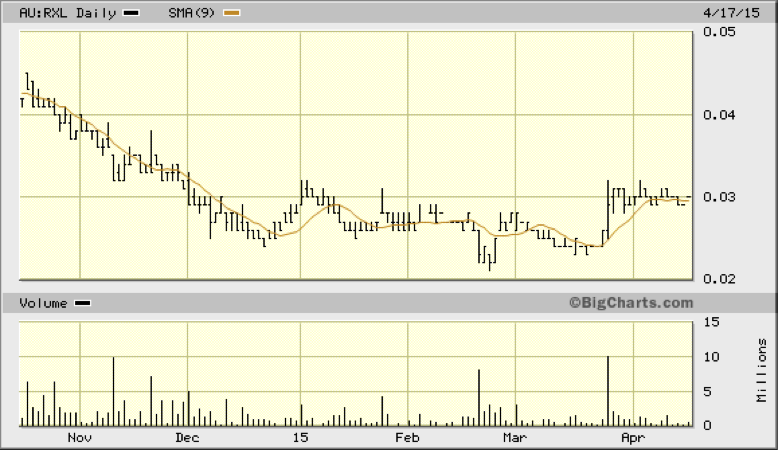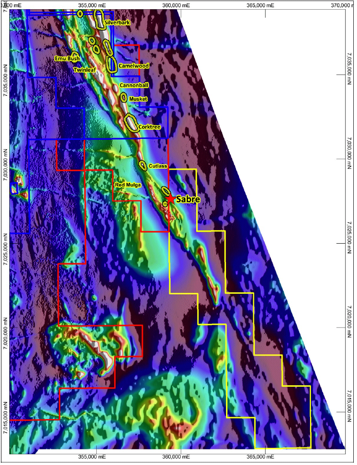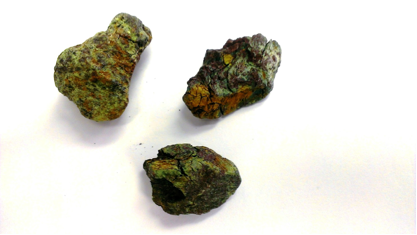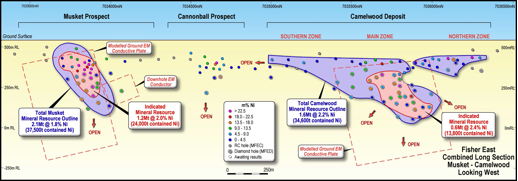Rox Resources (ASX: RXL, Share Price: $0.03, Market Cap: $25m) is one of our most highly-credentialed exploration plays, with three highly-prospective projects – its Fisher East nickel sulphide project in Western Australia, followed by two secondary projects – the Reward zinc and Bonya copper projects, both situated within the Northern Territory. We introduced the stock to our Portfolio during May and our most recent coverage was in our MineLife Weekly 198 during February 2015.
Rox has advised of yet another new nickel sulphide discovery, Sabre, within its Fisher East nickel project, identified from a recently completed air-core drilling program, situated 6km south of the Musket deposit.

Market Significance
Rox’s share price has firmed from a recent low of $0.021 during February on the back of the announcement of positive Scoping Study results for the Fisher East nickel project, along with the confirmation of yet another sulphide nickel discovery at Sabre. The discovery was made using methods developed by Rox’s exploration team that successfully discovered the Camelwood, Musket and Cannonball deposits. These latest developments reinforce our confidence in the company’s exploration credentials and track-record, which we are confident will lead to further share price appreciation.
Announcement Detail
Rox has reported that recently completed air-core drilling has identified another supplied nickel discovery within its Fisher East project, 500km north of Kalgoorlie in Western Australia. The newly-identified Sabre prospect is located 6km south of the existing Musket nickel deposit, within E53/1802 – which was acquired during late 2014 under an option agreement with a local prospector.
The results include:
- FEAC 278 – 8m @ 0.87% Ni, 1,500ppm Cu, 330ppb PGE (Pd+Pt+Au) from 72-80m depth, including 5m @ 1.08% Ni from 74-79m
- FEAC 277 – 6m @ 0.45% Ni, 130ppm Cu, from 47-53m
- FEAC 293 – 6m @ 0.40% Ni, 808ppm Cu, 25ppb PGE from 65-71m
- FEAC 292 – 2m @ 0.35% Ni, 124ppm Cu from 79-81m

Technical Significance
The nickel targets were identified using methods developed by Rox’s exploration team, which successfully discovered the Camelwood, Musket and Cannonball deposits. The high copper (Cu) and platinum group element (PGE) values within holes FEAC278 and 293 are on sections 200m apart along strike – and are strongly suggestive of massive sulphides at depth.
The highly-anomalous copper, platinum and palladium results over a strike length of 200m are by far the best identified by Rox to date, with the nickeliferous gossan indicative of nickel sulphide mineralization. There is a growing understanding that these aren’t merely isolated deposits and that the Fisher East ultramafic belt is shaping up as a new nickel sulphide camp, potentially similar to Kambalda and Leinster.
Holes FEAC 277 and 292 were not assayed for PGE’s. Further results from the air-core drilling program will be released as they progressively become available over the next few weeks. An RC drilling rig is being sourced to further test the mineralisation at Sabre.

Figure 1: Nickeliferous gossan, containing the mineral gaspeite (Ni,Fe,Mg) CO3, from air-core hole FEAC278 at the Sabre prospect. Gaspeite is known from only a handful of locations worldwide. Aside from its type locality in Canada, gaspeite is found in the nickeliferous gossans of Kambalda-type komatiitic nickel ore deposits in Kambalda and the nearby Widgiemooltha town-site, both south of Kalgoorlie in Western Australia
Fisher East Scoping Study
Rox recently released Scoping Study results related to its Fisher East nickel project. The overall outcomes are enormously prospective and suggest the likelihood for a robust nickel sulphide development – initially by way of a low-risk/low-capex toll-treatment operation (the Toll Case) over the initial years – before expanding to a stand-alone operation (the Base Case) that can be constructed and fully-funded via existing stage-one cash flow.
- The “Toll Case” is based on the assumption of hauling run-of-mine (ROM) ore at a production rate of 250,000 tpa to a nearby processing plant for toll-treatment. The Toll Case requires negotiation of an agreement with this third party processing facility which has not yet occurred.
- The “Base Case” scenario meanwhile encompasses an assumed processing and production rate of 500,000 tpa in order to produce between 8,000 and 10,000 tonnes of contained nickel-in-concentrate annually.
Technical Significance
- For both the Base and Toll scenarios, C1 cash operating costs are likely to be similar to existing nickel sulphide projects operating in the Kambalda district such as Mincor and Independence, at between US$4 and US$5/lb.
- Up-front capital costs are relatively low, comprising $85m for the Base Case (which includes $60m for a new 0.5Mtpa processing plant and additional capital including mine development and infrastructure capital). Alternatively, the Toll Case requires $20.8m (which includes $10.2m of mine development capital, with additional capital for haul road upgrade and infrastructure).
- Based on current nickel prices, the Toll Case produces a more attractive financial return than the Base Case, but that quickly changes if further resources can be added to the mining inventory or nickel prices increase.
- Dependent upon on project approvals and financing, development could commence within 18-24 months, and there are a number of optimisation opportunities that could substantially improve financial outcomes.
- The project will benefit from a lower A$, falling labour costs, lower diesel prices and declining construction costs.
The biggest consideration in all of this is that the Mineral Resources at the Camelwood and Musket deposits have not yet fully defined. Drilling completed late last year, after the resource estimation for Musket was completed, has already significantly extended the mineralisation outside current resource boundaries, whilst significant mineralisation has also been recorded at the Cannonball prospect. The resource potential is best illustrated in the graphic below.

Drilling at the Camelwood and Musket nickel prospects has defined a JORC 2012 Mineral Resource comprising 3.6Mt grading 2.0% nickel at a 1.0% Ni cut-off grade for 72,100 tonnes of contained nickel. Importantly, higher-grade mineralisation exists in both deposits and remains open at depth beneath each deposit. The nickel Mineral Resource occurs partly on tenements under Option to Purchase to Rox, with an exercise price payable of $2.3 million by 30 June 2015.
Drilling by Rox has also defined numerous high-grade gold targets and a JORC 2004 Measured, Indicated and Inferred Mineral Resource comprising 973,000 tonnes grading 2.75 g/t gold at a 0.8 g/t Au cut-off for 86,000 ounces of contained gold over the Damsel, Moray Reef and Mt Fisher deposits.
Summary
Given the company’s high level of exploration success and the promising emerging economics of its Fisher East project, we retain our positive outlook on Rox Resources. Ultimately, we believe higher share price levels are inevitable, particularly as Fisher East moves closer towards commercialisation and is steadily de-risked. The company’s Fisher East nickel sulphide project is an exciting discovery, particularly as there had been no prior systematic exploration for nickel prior to Rox’s involvement.
We have little doubt that if Fisher East was situated within the Fraser Range province (which is the current exploration hotspot with which the market is currently enamoured), then Rox’s share price and market value would be substantially higher. What is encouraging however is the fact that recent Scoping Study results along with the discovery of the Sabre prospect have been warmly received by the market and have had a positive impact von Rox’s share price.
We retain our Hold recommendation on Rox Resources as we already have a very strong existing position in the stock, although current prices represent a very good entry point for new investors.







